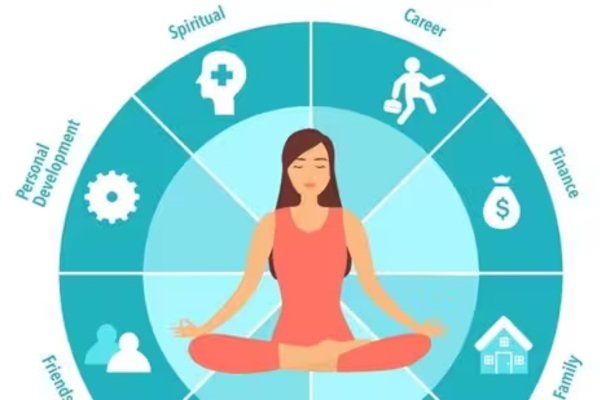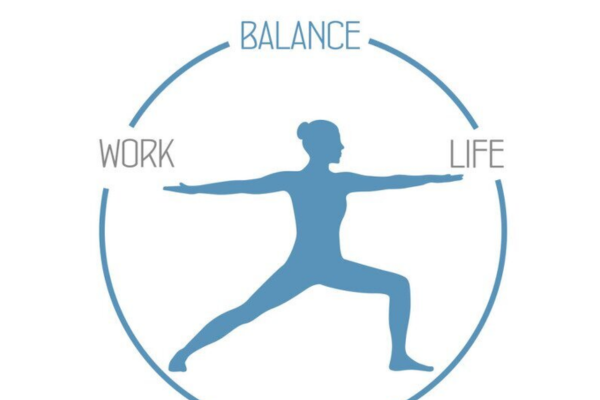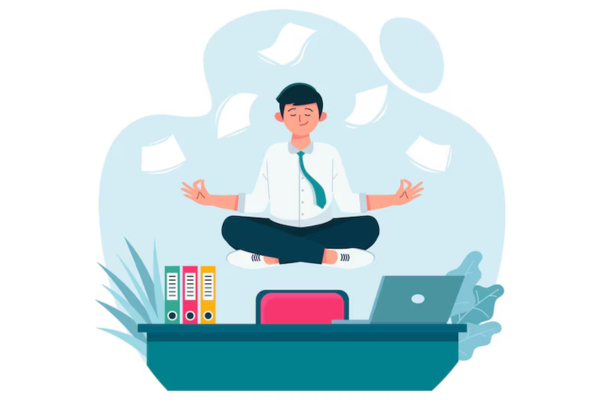In today’s fast-paced world, the concept of work-life balance has become more challenging to achieve than ever before. We live in an era where constant connectivity and the blurring of boundaries between work and personal life have made it nearly impossible to switch off and recharge. While many of us strive to achieve a balanced life, we often feel as though we’re falling short, overwhelmed by the pressures of modern living. But what if the missing piece to this puzzle isn’t just about time management but something much deeper—something that connects mind, body, and soul?
Why work-life balance is becoming increasingly elusive? the key elements missing in most people’s approach to harmony? can yoga and mindfulness practices can help restore that balance? if yes, then how?

The Rise of a Work-Obsessed Culture
Before diving into solutions, it’s crucial to understand how we got here. The notion of work-life balance has shifted dramatically over the years. In the past, leaving work at the office was a reality for many, and Sundays were a time to unwind. However, with the advent of smartphones, remote work, and global connectivity, the lines between professional and personal life have blurred.
Constant Connectivity
One of the key reasons work-life balance feels more unattainable is the 24/7 connectivity that the modern workforce has embraced. The expectation to be available at all times—responding to emails, attending virtual meetings, or working on projects—has made it difficult for individuals to set clear boundaries.
Rise of Remote Work
While remote work has its perks, it has also contributed to an imbalance. Many professionals now find themselves working longer hours, feeling isolated, or unable to mentally disconnect from work tasks, which can lead to burnout. The home, once a place for relaxation and family time, has become an extended workspace.
Societal Expectations and Productivity Pressure
Culturally, we’ve equated productivity with success, and the idea of “hustling” or “grinding” has been glamorized. This culture of overwork and under-rest leaves little room for hobbies, self-care, or even spending quality time with loved ones. The pressure to excel professionally often overshadows the importance of nurturing our personal lives.
The Impact of Imbalance on Health and Well-Being
This relentless pace doesn’t just affect our work; it has profound consequences on our physical and mental well-being. Chronic stress, anxiety, and a lack of fulfillment are becoming all too common in today’s society.
Physical Health
Prolonged exposure to stress can weaken the immune system, increase blood pressure, and contribute to heart disease. The lack of time for physical activities like exercise further exacerbates these issues. Many individuals spend their days hunched over a desk, leading to poor posture, back pain, and even more significant health complications.

Mental Health
Mental health issues are on the rise, largely due to the demands of modern work life. Burnout, anxiety, and depression are becoming more prevalent. When work becomes all-consuming, there’s little time left for self-care, relaxation, or hobbies that bring joy and mental relief.
Personal Relationships
The imbalance between work and life also takes a toll on relationships. People often find it challenging to spend meaningful time with family or friends, leading to feelings of isolation, guilt, or resentment.
The Missing Piece: A Holistic Approach
While managing time more efficiently and setting boundaries are often touted as solutions, they alone may not be sufficient to achieve true balance. What’s missing is a holistic approach—one that considers not just how we allocate time between work and personal life but how we nurture our mind, body, and spirit.
Yoga: The Path to Balance
Yoga is more than just physical exercise; it is a practice that promotes mindfulness, inner peace, and self-awareness. By incorporating yoga into daily life, individuals can reconnect with themselves, quiet the noise of the external world, and bring harmony back into their lives.
Here’s how yoga can be the missing piece in achieving work-life balance:
1. Mindfulness and Awareness
Yoga teaches mindfulness, the practice of being fully present in the moment. In a world where we’re often thinking about the next task or replaying past events, this sense of awareness is vital. Practicing yoga helps slow down the mind, allowing us to focus on the here and now.
Mindfulness doesn’t just apply to yoga sessions. It can be carried into daily life, helping you become more attuned to your needs, feelings, and surroundings. This awareness can help create a better distinction between work time and personal time, enabling you to “switch off” more effectively when needed.
2. Physical Movement and Release
Yoga is an incredible way to relieve the physical tension accumulated from long hours of sitting or working. Many yoga poses focus on stretching and strengthening muscles, improving posture, and enhancing flexibility. By addressing the physical strain that often accompanies a demanding work life, yoga provides a sense of release and renewal.
Poses such as Child’s Pose, Downward Dog, and Mountain Pose are excellent for grounding the body and relieving tension. A consistent yoga routine helps prevent burnout by reducing physical stress and promoting better body mechanics.

3. Breathing and Stress Reduction
One of the most effective yet underappreciated aspects of yoga is pranayama or breath control. The simple act of deep, conscious breathing can have profound effects on our stress levels. When we’re overwhelmed by work or personal commitments, our breathing often becomes shallow, exacerbating stress and anxiety.
Incorporating breathing exercises like Alternate Nostril Breathing or Ujjayi Breath can help calm the nervous system, reduce stress hormones like cortisol, and promote relaxation. Over time, yoga practitioners find that they can use these techniques in stressful work situations, making it easier to manage the demands of both work and personal life.
4. Mental Clarity and Focus
Yoga isn’t just about relaxing and unwinding. It also sharpens the mind and enhances focus. Through the practice of meditation and mindful movement, yoga cultivates mental clarity, helping you prioritize tasks and make more conscious decisions.
Instead of juggling multiple responsibilities simultaneously, yoga teaches us the importance of being fully immersed in the present. This leads to more effective time management and productivity, allowing you to focus on tasks at hand without feeling overwhelmed.
5. Creating Sacred Time
One of the most significant challenges in achieving work-life balance is creating time for yourself. Yoga offers a space—a sacred time—where you can reconnect with your inner self. It becomes an intentional practice where you focus on your own well-being, both mentally and physically.
This sense of self-care is essential for achieving balance. By carving out even 10–15 minutes a day for yoga, you’re sending a message to yourself that your well-being matters. Over time, this practice will help reduce feelings of guilt or inadequacy for taking time away from work.
Incorporating Yoga Into Your Daily Life
Integrating yoga into your routine doesn’t have to be overwhelming. Here are some simple ways to start:

- Morning Routine: Begin your day with a short yoga session to center yourself. Even 10 minutes of sun salutations or a few stretches can set a positive tone for the day.
- Work Breaks: Incorporate a few yoga stretches or breathing exercises during work breaks. This will help release tension and refresh your mind.
- Evening Wind-Down: End your day with a gentle yoga practice to relax your mind and body, preparing for restful sleep.
- Mindful Breathing: Practice deep breathing exercises throughout the day, especially during moments of stress.
Beyond Yoga: Other Ways to Cultivate Work-Life Balance
While yoga is a powerful tool, it works best when combined with other lifestyle changes. Here are some additional strategies for achieving harmony in your life:
- Set Boundaries: Be intentional about separating work from personal time. Establish clear working hours and avoid checking emails or taking work calls during off-hours.
- Prioritize Self-Care: Make time for activities that bring you joy and relaxation, whether it’s spending time with loved ones, reading, or engaging in a hobby.
- Practice Gratitude: Focus on the positives in your life. Gratitude journaling can help shift your mindset from stress and overwhelm to appreciation and abundance.
- Limit Screen Time: Excessive screen time can contribute to stress and anxiety. Set limits for social media, work-related activities, and even television, allowing more time for real-life connections.
Conclusion: Achieving Balance Through Yoga and Mindful Living
Work-life balance may feel elusive, but it is possible with the right approach. By embracing yoga, mindfulness, and intentional living, you can create a harmonious life where both work and personal fulfillment coexist peacefully. The missing piece isn’t just more time; it’s cultivating the practices that nurture your entire being.
So, next time you feel overwhelmed, remember to pause, breathe, and come back to your center. The journey to balance begins with a single breath and a mindful intention to live a life of harmony.
